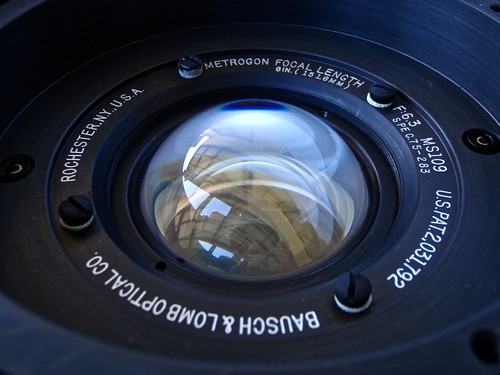Difference between revisions of "Metrogon"
m (removed Category:Lens; added Category:Lenses using HotCat) |
m (Minor text adjustment) |
||
| Line 9: | Line 9: | ||
| − | The Metrogon is an extra-wide field photographic lens used extensively by the US military for use in [[Aerial camera | aerial photography]]. The design is by [[Bausch & Lomb]] based on the [[Topogon]] design by [[Carl Zeiss | Zeiss]]. It is composed of a double-Gauss design with an extremely curved meniscus to provide a 90° field of view. The lens is symmetrical front to back. The two outer positive elements are of high index crown glass while the two inner negative elements are of a high index flint glass.<ref>[http://www.metrogon.20megsfree.com/ Metrogon lens page]</ref> | + | The '''Metrogon''' is an extra-wide field photographic lens used extensively by the US military for use in [[Aerial camera | aerial photography]]. The design is by [[Bausch & Lomb]] based on the [[Topogon]] design by [[Carl Zeiss | Zeiss]]. It is composed of a double-Gauss design with an extremely curved meniscus to provide a 90° field of view. The lens is symmetrical front to back. The two outer positive elements are of high index crown glass while the two inner negative elements are of a high index flint glass.<ref>[http://www.metrogon.20megsfree.com/ Metrogon lens page]</ref> |
The lens was used in [[Fairchild]] K17C, KA3, K-22, T-11, KC-1, KC-1B, and KC-9A aerial cameras. | The lens was used in [[Fairchild]] K17C, KA3, K-22, T-11, KC-1, KC-1B, and KC-9A aerial cameras. | ||
Revision as of 02:40, 6 December 2014

|
| Bausch & Lomb Metrogon (in Fairchild K-22 Aerial Camera Replacement Lens cone) image by Dirk HR Spennemann (Image rights) |
The Metrogon is an extra-wide field photographic lens used extensively by the US military for use in aerial photography. The design is by Bausch & Lomb based on the Topogon design by Zeiss. It is composed of a double-Gauss design with an extremely curved meniscus to provide a 90° field of view. The lens is symmetrical front to back. The two outer positive elements are of high index crown glass while the two inner negative elements are of a high index flint glass.[1]
The lens was used in Fairchild K17C, KA3, K-22, T-11, KC-1, KC-1B, and KC-9A aerial cameras.
The lens rim cites the U.S. Patent number (US 2031792) which is in fact the Carl Zeiss Jena Patent for the Topogon (design by Robert Richter in 1933).[2]